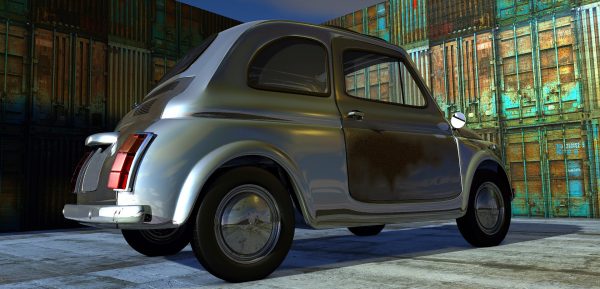Was Normal & Bump Maps gemeinsam haben.
Normal und Bump Maps dienen beide dem gleichen Zweck: Sie simulieren den Eindruck einer detaillierten 3D-Oberfläche, indem Sie das Shading so modifizieren, als ob die Oberfläche viele kleine Winkel hätte, anstatt völlig flach zu sein.
Da es sich nur um eine Änderung des Shadings jedes einzelnen Pixels handelt, wirft dies keine Schatten und behindert keine anderen Objekte.
Wenn der Kamerawinkel zu flach zur Oberfläche ist, werden Sie feststellen, dass die Oberfläche nicht wirklich geformt ist.

Sowohl Bump als auch Normal Maps funktionieren, indem sie den normalen Winkel (die Richtung, die senkrecht zu einer Fläche zeigt) ändern, was das Shading eines Pixels beeinflusst. Obwohl die Begriffe Normal und Bump Map oft synonym verwendet werden, gibt es gewisse Unterschiede.
Bump Maps.
Dies sind Texturen, die eine Intensität, die relative Höhe der Pixel aus der Sicht der Kamera speichern. Die Pixel scheinen um den erforderlichen Abstand in Richtung der Flächen-Normals verschoben zu werden. (Die „Beule“ besteht nur aus einer Verschiebung, die entlang des bestehenden und unveränderten Normalvektors der Fläche stattfindet). Sie können entweder Graustufenbilder oder die Intensitätswerte einer RGB-Textur (einschließlich Bilder) verwenden.
.
Normal Maps.
Dies sind Bilder, die die Richtung der Normals direkt in den RGB-Werten eines Bildes speichern. Sie sind viel genauer, da sie nicht nur simulieren, dass das Pixel entlang einer Linie vom Gesicht entfernt ist, sondern auch simulieren können, dass das Pixel in jede Richtung und auf beliebige Weise bewegt wird. Die Nachteile von Normal Maps sind, dass Sie im Gegensatz zu Bump-Maps, die leicht von Hand gemalt werden können, Normal Maps in der Regel in irgendeiner Weise erzeugt werden müssen, oft aus Geometrien mit höher Auflösung als die Geometrie, auf die Sie die Map anwenden.
Normal Maps in Blender speichern einen Normalwert wie folgt:
- Rote Maps von (0 – 255) bis X (-1.0 – 1.0)
- Grüne Maps von (0 – 255) bis Y (-1.0 – 1.0)
- Blaue Maps von (0 – 255) bis Z (0.0 – 1.0)
Da Normals alle auf einen Betrachter zeigen, werden negative Z-Werte nicht gespeichert (sie wären sowieso unsichtbar). In Blender speichern wir einen vollen blauen Bereich, obwohl einige anderen Implementierungen auch blaue Farben (128 – 255) auf (0.0 – 1.0) abbilden. Letzte Konvention wird z.B. ind „Doom 3“ verwendet.
Workflow.
Die Schritte, die bei der Erstellung und Verwendung von Bump & Normal Maps durchgeführt werden, sind:
- Modellieren Sie ein hochdetailliertes („Hi-Poly“)-Modell.
- Baken Sie die Bump- und/oder Normal-Map.
- Erstellen Sie ein Low-Poly, weniger detailliertes Modell.
- Ordnen Sie die Map dem Low-Poly-Modell mit einem gemeinsamen Koordinatensystem zu.
Das Baken eines Modells, einfach ausgedrückt, besteht darin, das Detail eines hohen Polygonmeshes zu nehmen und es auf ein ähnliches Objekt anzuwenden. Das ähnliche Objekt ist identisch mit dem High-Poly-Mesh, mit Ausnahme von weniger Nodes. Verwenden Sie dazu die Funktion Render Bake in Blender.
Modellierung eines Low-Poly mit den Mesh-Bearbeitungswerkzeugen von Blender. Im Allgemeinen sollten die gleichen oder ähnliche Flächen vorhanden sein, die das Modell widerspiegeln. So kann beispielsweise ein hochdetailliertes Ohr im High-Poly-Modell 1000 Gesichter aufweisen. Im Low-Poly-Modell kann diese durch eine einzige Ebene ersetzt werden, die in die gleiche Richtung wie das detaillierte Ohrmesh ausgerichtet ist. (Tipp: Die Multi-Resolution Mesh-Modellierungsfunktion von Blender kann hier sehr gut eingesetzt werden).
Mapping ist der Prozess des Auftragens einer Textur auf das Loy-Poly-Mesh. Weitere Informationen zum Anwenden einer Textur auf das Material eines Mesh finden Sie in unserem Beitrag zum Texture Mapping. Besondere Überlegungen für Bump und Normal Maps sind:
- Wenn Sie eine Bump-Map verwenden, mappen Sie die Textur auf das Normal und aktivieren Sie kein RGB.
- Wenn Sie eine Normal Map verwenden, ordnen Sie die Textur auf das Normal zu.
Die Koordinatensysteme der beiden Objekte müssen übereinstimmen. Wenn Sie beispielsweise mit einer UV-Map des High-Poly-Modells baken, müssen Sie das Low-Poly-Modell UV-Maps erstellen und die UV-Koordinaten so ausrichten, dass sie mit der Kontur des High-Poly-Bildes übereinstimmen.
Vielen Dank für ihren Besuch


